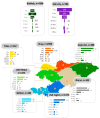Collective Immunity to the Measles, Mumps, and Rubella Viruses in the Kyrgyz Population
- PMID: 40266124
- PMCID: PMC11945377
- DOI: 10.3390/vaccines13030249
Collective Immunity to the Measles, Mumps, and Rubella Viruses in the Kyrgyz Population
Abstract
Specific prevention of measles, mumps, and rubella (MMR) is the main prerequisite for a radical reduction in the incidence of these infections in the Kyrgyz Republic (KR). An increase in the number of seronegative individuals observed in recent years has led to an increase in measles incidence. This is directly related to a decrease in collective immunity, which provides protection for the population only in conditions of a high density of immunized individuals and their uniform distribution in the population. The only way to estimate the number of immunized individuals is by conducting serological surveys of collective immunity.
Aim of the study: The aim was to study the level of collective immunity to the MMR viruses in the KR.
Materials and methods: This study involved a cohort of 6617 residents (volunteers) aged 1 to 70+ years, formed in accordance with the Rospotrebnadzor program "Assessment of collective immunity to vaccine-preventable and other relevant infections" and stratified by age and region of residence. During the study, participants filled out a questionnaire and gave venous blood samples to determine IgG antibodies to MMR viruses (ELISA using certified Russian test systems).
Results: In December 2023, collective immunity ensured epidemiological well-being only with respect to rubella. The volunteer seropositivity was 94.2% (95% CI: 93.7-94.8). The average measles seropositivity was 78.9% (95% CI: 77.9-79.9). It was significantly lower in children aged 1-17 years and significantly higher than the cohort average in individuals aged ≥18 years. The average mumps seropositivity was 76.4% (95% CI: 75.3-77.4), with the minimum level noted among individuals aged 12-29 years (63.8%; 95% CI: 61.4-66.2). The maximum levels of mumps seropositivity were noted among children aged 6-11 years and older adults who had likely experienced mumps (50-70+ years). Seroprevalence distributions by activity correlated with age distributions (all infections).
Conclusions: The system of targeted prophylaxis of vaccine-preventable infections adopted in the KR has contributed to the formation of a high level of rubella collective immunity and, to a lesser extent, measles and mumps immunity. The recent trend towards increases in measles and mumps incidence in the KR requires additional efforts to increase collective immunity to these infections.
Keywords: Kyrgyz Republic; antibodies; cohort study; collective immunity; measles; mumps; population; rubella; seroprevalence.
Conflict of interest statement
We declare we have no competing interests.
Figures













Similar articles
-
Measles, mumps, rubella and varicella antibodies among international and domestic university students.J Travel Med. 2024 Jan 28;31(1):taae004. doi: 10.1093/jtm/taae004. J Travel Med. 2024. PMID: 38195239
-
Assessment of immune status against measles, mumps, and rubella in young Kuwaitis: MMR vaccine efficacy.J Med Virol. 2020 Aug;92(8):963-970. doi: 10.1002/jmv.25665. Epub 2020 Feb 3. J Med Virol. 2020. PMID: 31919861
-
[Age-related seroprevalence of measles, mumps and rubella antibodies in 1996].Schweiz Med Wochenschr. 1998 Apr 25;128(17):649-57. Schweiz Med Wochenschr. 1998. PMID: 9622837 German.
-
Waning immunity and potential asymptomatic infection in 3-7 years old children who received one dose of measles-mumps-rubella vaccine: A 4-year prospective study.Vaccine. 2021 Jun 11;39(26):3509-3515. doi: 10.1016/j.vaccine.2021.05.008. Epub 2021 May 13. Vaccine. 2021. PMID: 33994238
-
Vaccines for measles, mumps, rubella, and varicella in children.Cochrane Database Syst Rev. 2020 Apr 20;4(4):CD004407. doi: 10.1002/14651858.CD004407.pub4. Cochrane Database Syst Rev. 2020. Update in: Cochrane Database Syst Rev. 2021 Nov 22;11:CD004407. doi: 10.1002/14651858.CD004407.pub5. PMID: 32309885 Free PMC article. Updated.
Cited by
-
Herd Immunity to the Measles, Mumps and Rubella Viruses Among the Belgradian Population in May, 2024.Vaccines (Basel). 2025 Jun 18;13(6):652. doi: 10.3390/vaccines13060652. Vaccines (Basel). 2025. PMID: 40573983 Free PMC article.
References
-
- Popova A.Y., Smirnov V.S., Andreeva E.E., Babura E.A., Balakhonov S.V., Bashketova N.S., Bugorkova S.A., Bulanov M.V., Valeullina N.N., Vetrov V.V., et al. SARS-CoV-2 Seroprevalence Structure of the Russian Population during the COVID-19 Pandemic. Viruses. 2021;13:1648. doi: 10.3390/v13081648. - DOI - PMC - PubMed
-
- Popova A.Y., Kasymov O.T., Smolenski V.Y., Smirnov V.S., Egorova S.A., Nurmatov Z.S., Milichkina A.M., Gulmira S., Suranbaeva G.S., Kuchuk T.E., et al. SARS-CoV-2 herd immunity of the Kyrgyz population in 2021. Med. Microbiol. Immunol. 2022;211:195–210. doi: 10.1007/s00430-022-00744-7. - DOI - PubMed
-
- Popova A.Y., Egorova S.A., Smirnov V.S., Ezhlova E.B., Milichkina A.M., Melnikova A.A., Bashketova N.S., Istorik O.A., Buts L.V., Ramsay E.S., et al. Immunity to measles, rubella and mumps herd immunity to vaccine preventable infections in SaintPetersburg and the Leningrad region: Serological status of measles, mumps, and rubella. Russ. J. Infect. Immun. 2024;14:1187–1208. doi: 10.15789/2220-7619-HIT-17797. - DOI
-
- Popova A.Y., Totolian A.A. Methodology for assessing herd immunity to the SARS-CoV-2 virus in the context of the COVID-19 pandemic. Russ. J. Infect. Immun. 2021;11:609–616. doi: 10.15789/2220-7619-MFA-1770. (In Russian) - DOI
-
- Gadroen K., Dodd C.N., Muscle G.M.C., de Ridder M.A.J., Weibel D., Mina M.J., Grenfell B.T., Sturkenboom M.C.J.M., van de Vijver D.A.M.C., de Swart R.L. Impact and longevity of measles-associated immune suppression: A matched cohort study using data from the THIN general practice database in the UK. BMJ Open. 2018;8:e021465. doi: 10.1136/bmjopen-2017-021465. - DOI - PMC - PubMed
LinkOut - more resources
Full Text Sources
Research Materials

